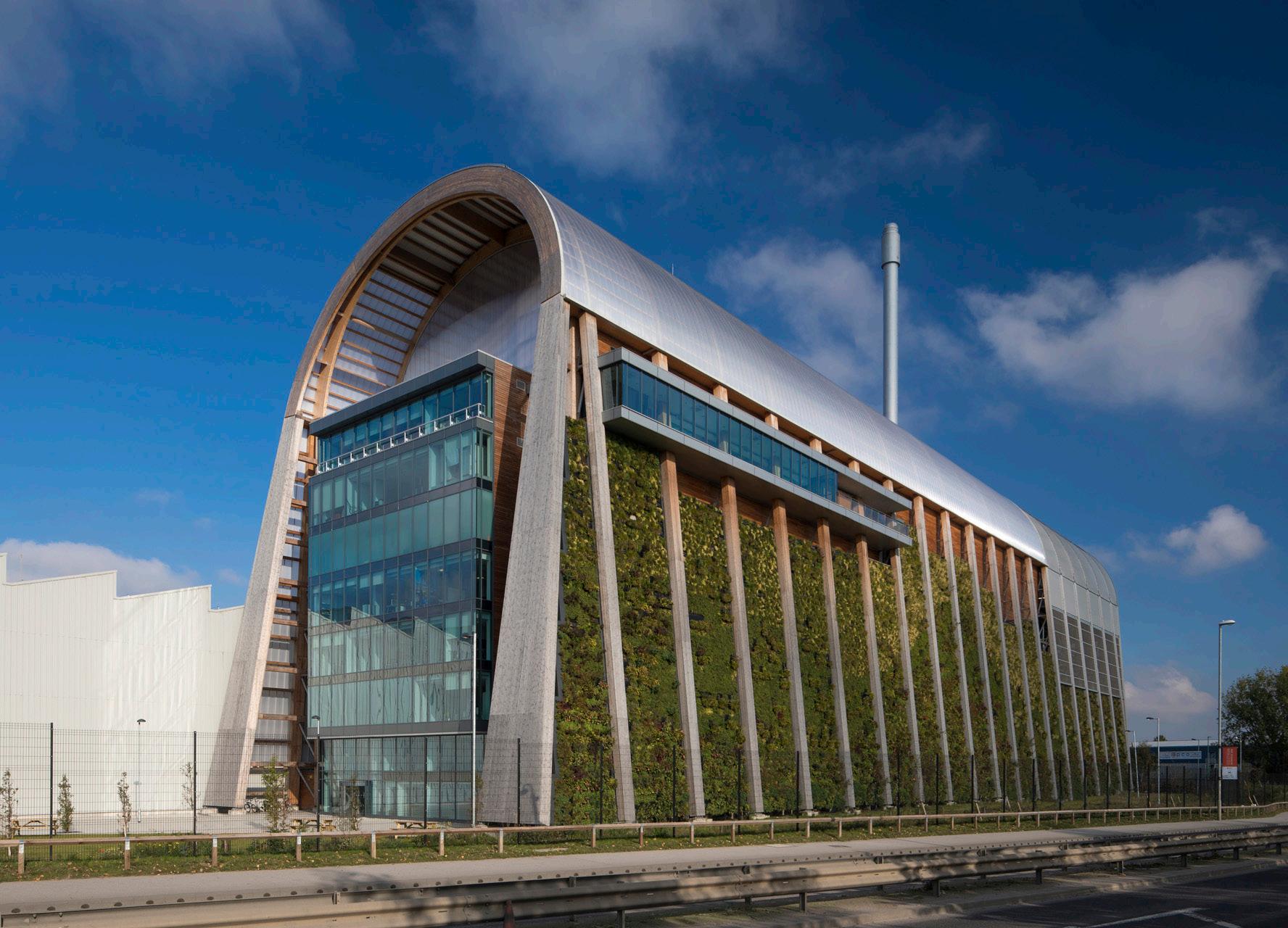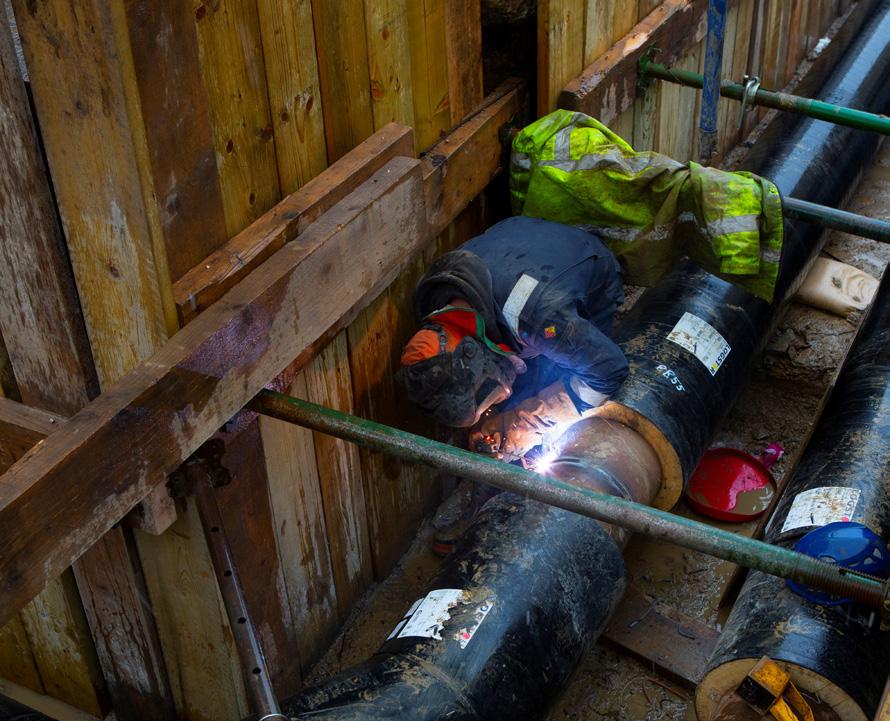
9 minute read
LEEDS PIPES DISTRICT HEATING NETWORK
by George Munson, Senior Project Manager and Chad Newton, Senior Policy and Communications Officer at Leeds City Council
Like most local authorities, Leeds City Council has declared a climate emergency in 2019 and committed to working towards becoming a carbon-neutral city. Key to this ambition will be the decarbonisation of heat, which in 2019 represented just under a quarter (23%) of UK carbon emissions. The council views its heat and energy related policies and projects as an opportunity to address its environmental challenges as well as supporting the one-in-six households in Leeds that were classed as living in fuel poverty in 2019. The Leeds PIPES district heating network is a great example of one of these projects. Project background
Advertisement
The £49 million ‘Leeds PIPES’ network was imagined and developed with the aim of providing affordable, reliable, and low carbon heat and hot water to benefit both the council and commercial customers.
‘Affordable’ means that the network is designed to provide heat to connected commercial customers at competitive and attractive rates, whilst at the same time providing heat to connected social housing tenants at cheaper rates than alternative technologies, helping to alleviate fuel poverty. Being linked to an energy from waste facility means prices are less volatile than the global fossil fuel-based energy market. ‘Reliable’ means that the network provides a consistent service that customers can rely on, with multiple layers of resilience designed in to ensure continuity of supply. ‘Low carbon’ means that heat from the network is significantly less carbon intensive than electricity from the grid or other traditional methods of heating building, namely gas or oil. The scheme currently uses energy recovered from the city’s nonrecyclable household waste at the Leeds Recycling and Energy Recovery Facility (RERF). There are around 360,000 homes in the city and most of these have their waste collected by Leeds City Council and taken to the RERF. With the average household in Leeds producing enough waste each year to recover around 1.3 megawatt-hours of heat, the RERF has significant heat generation capacity. This potential use of the facility for heat supply was considered at the earliest stages of developing the site and informed the council’s approach to procuring a long-term operator. Theoretically, once any network of insulated underground pipes is in place then it could be retrofitted so that any heat source—or combination of heat sources—could be used to power the network. Despite not technically being powered using a ‘renewable’ resource, the Leeds PIPES project helps cut the city’s carbon footprint in multiple significant ways. First, recovering energy from waste releases fewer (and less potent) greenhouse gas emissions than waste sent to landfill. Second, the energy that is recovered from waste can be converted into either electricity or (more efficiently) heat as a byproduct which reduces the burning of fossil fuels. Typically, the RERF produces 5-7+ units of heat for each unit of electricity sacrificed, which is significantly better than any heat pump on the market. Third, heating

a building by connecting it to a district heating network typically replaces or makes redundant less sustainable heating methods such as gas combustion systems. The Leeds PIPES network supports the council’s long-term ambition of the district becoming the first net zero major city in the country.
Stakeholder buy-in
When the council first began consulting prospective customers about connecting to the network, a clear message came back that customers would only seriously negotiate once construction had started, and ideally with the network already operational. However, without a firm idea of potential customers, the risks of beginning construction were high. In response to this concern the council took a calculated risk, underpinned by ‘anchor’ connections to its own social housing and public sector partners, to commence construction on the assumption that new customers would connect once district heating infrastructure was available.
This assumption is now being realised but is a real barrier to many large strategic networks ever commencing. It was made possible in Leeds in part due to successful engagement with regional, national, and European bodies to secure a combination of grants and use of our own lowinterest borrowing capability. Leeds PIPES continues to expand and is regularly connecting to new buildings with the expectation of becoming one of the UK’s largest heat networks in the near future.
Around 1,800 residential properties, 8 public buildings, and 2 commercial buildings are currently connected to the network. Several more customers (including the Ministry of Justice and a second major connection to the Leeds Teaching Hospitals Trust) have recently announced plans to connect and discussions are progressing well with many potential customers. Stakeholder engagement was also important for minimising disruption. The project team worked with highways officers to coordinate pipe-laying and planned roadworks to minimise the duration of road closures and their associated impacts. Similarly, as domestic connections involved work in people’s homes, close liaison with council housing team helped reduce the number of
visits and therefore disruption for both tenants and installers.
Project execution
Leeds PIPES began construction in 2018 and was constructed in three phases, some of which were constructed in parallel. Phase 1 was completed during 2019, phase 2 in 2020, and construction on phase 3 has now commenced.
Phases 1 and 2 of the network were designed to facilitate connections for public sector organisations and council buildings. Once phase 3 is installed and operational, we expect new customers to primarily be new developments, with a mix of residential, student accommodation and non-domestic customers. Every new connection helps to raise the profile of the network in the city, attracting potential customers and reaffirming the viability of district heating connections. Resilience was considered at an early stage. A new energy centre was created to take low energy steam from the RERF and convert it into low-temperature hot water for the district heating network. A second energy centre at Saxton Gardens was created to meet peak demand and add resilience to the overall system using gas boilers, ensuring continuity of supply in all circumstances. Our approach to resilience has meant that there has never been a loss of heat to customers at any point. Whenever the RERF has had outages, the backup boilers at Saxton Gardens have automatically fired to ensure uninterrupted service is provided to customers. The project has received funding from a number of regional, national and European sources:
• £5.8m from the European Regional Development Fund to help connect 1,080 council homes to the network.
• £5.5m from the Heat Network Investment Project, managed by the Department for Business, Energy and Industrial Strategy (two separate grants for phase 2 and 3). • £4m from West Yorkshire Combined Authority and Leeds City Region Enterprise Partnership (LEP) through the Leeds City Region Growth Deal.
• £0.1m from the LEP Energy Accelerator programme, funded by the Leeds City Region Growth Deal and the European Investment Bank’s European Local Energy Assistance (ELENA) programme.

The business case for the Leeds PIPES network was approved on the basis that the council would attract additional customers to the network once the infrastructure had been installed and the benefits of connecting had been demonstrated. The council will continue to add commercial connections to the network over the next phase of works.
Unlike privately owned networks, the council isn’t driven to make a profit from the network, deliberately setting tariffs to be competitive with fossil fuelled alternatives to tackle fuel poverty and improve business competitiveness. Any surpluses generated are used to reduce debt, reinvest in expanding the network to serve even more of the city and, longer-term, to invest in additional low carbon heating sources.
Project evaluation
Leeds PIPES is now a well-established low carbon heat utility, with a rapidly growing customer base and several extensions under construction during 2022/23. It has collected four awards this year, demonstrating both innovation and a focus on meeting customers’ needs. By replacing thousands of polluting, inefficient fossil fuel powered heating systems with a more sustainable alternative the network is helping to cut Leeds’ carbon footprint and also improve local air quality. The network now stretches around 26 kilometres in length and work is currently underway to extend it another 2.5 kilometres to enable more buildings to connect.
Over the last financial year, more than 15,000 megawatt-hours of heating was provided by Leeds PIPES which helped reduce the city’s carbon footprint by more than 2,000 tonnes. The more buildings that connect and take heat from the network, the greater the positive environmental impact and phase three of the main spine extension is currently underway, increasing the connection capacity. It is estimated that the scheme has the capacity to save more than 16,000 tonnes of carbon from being emitted every year once fully built out. Unlike the use of electric storage heating or heat pumps, buildings connecting to the network also help to reduce demand on the city’s electricity grid, freeing up capacity as we transition to an increasingly electrified transport and heating system. Alongside environmental benefits, the network is currently providing around 1,800 homes with affordable warmth, supporting efforts to alleviate fuel poverty in some areas of the city experiencing high levels of deprivation. The network’s commercial customers are benefiting from competitive and predictable pricing of heat, supporting local economic growth. External factors, particularly the gas price volatility and institutional investors’ focus on carbon, mean that Leeds PIPES now has an even more compelling commercial offer. Finally, the project has helped employ more than 430 people in the local low carbon sector including 36 apprentices.
Future plans
In addition to constructing the third phase of the network and connecting new customers, work is already underway to prepare the Leeds PIPES network for future policy and regulatory changes. The government has committed to introducing ‘Heat Network Zoning’ policies by 2025. These zones will operate by designating areas within cities where buildings (and potentially heat sources) are mandated to connect to networks, unless exempt, enabling the expansion of networks where they are recognised to be the lowest cost way of decarbonising heat. It is expected that local authorities will have responsibility for coordinating Heat Network Zones and determining how they will operate. Leeds is well placed for the policy’s introduction after voluntarily participating in two government sponsored pilots. The council expects the introduction of zoning to increase heat network take up exponentially by removing the biggest barrier to initial establishment and strategic growth: uncertainty. The government has also announced that Ofgem will become a future regulator of heat networks with responsibilities including setting and enforcing regulatory requirements relating to the provision of information, pricing, technical standards, and quality of service standards to protect domestic and microbusiness consumers.
Heat networks are currently unregulated, with voluntary codes of practice and standards used by the better networks, but no obligation to use these for privately funded networks. As a result, there is significant variation in the customer service standards provided to customers and in the cost of heat. This variation is detrimental to public and stakeholder trust in district heating which inhibits growth, so the council is supportive of regulation. Although the full details of the regulation are yet to be announced, it is widely anticipated that the good practice required by BEIS district heating grant funds will be used as the basis of the quality standards. Leeds PIPES has been built in compliance with the Chartered Institution of Building Services Engineers (CIBSE) Code of Practice (a technical standard), has recently adopted the Heat Networks Investment Project (HNIP) developed legal documents, and has been developed to meet the requirements of the Heat Trust (a customer service standard). The network is in the process of formally joining the Heat Trust to improve its readiness for the incoming regulation even further.



